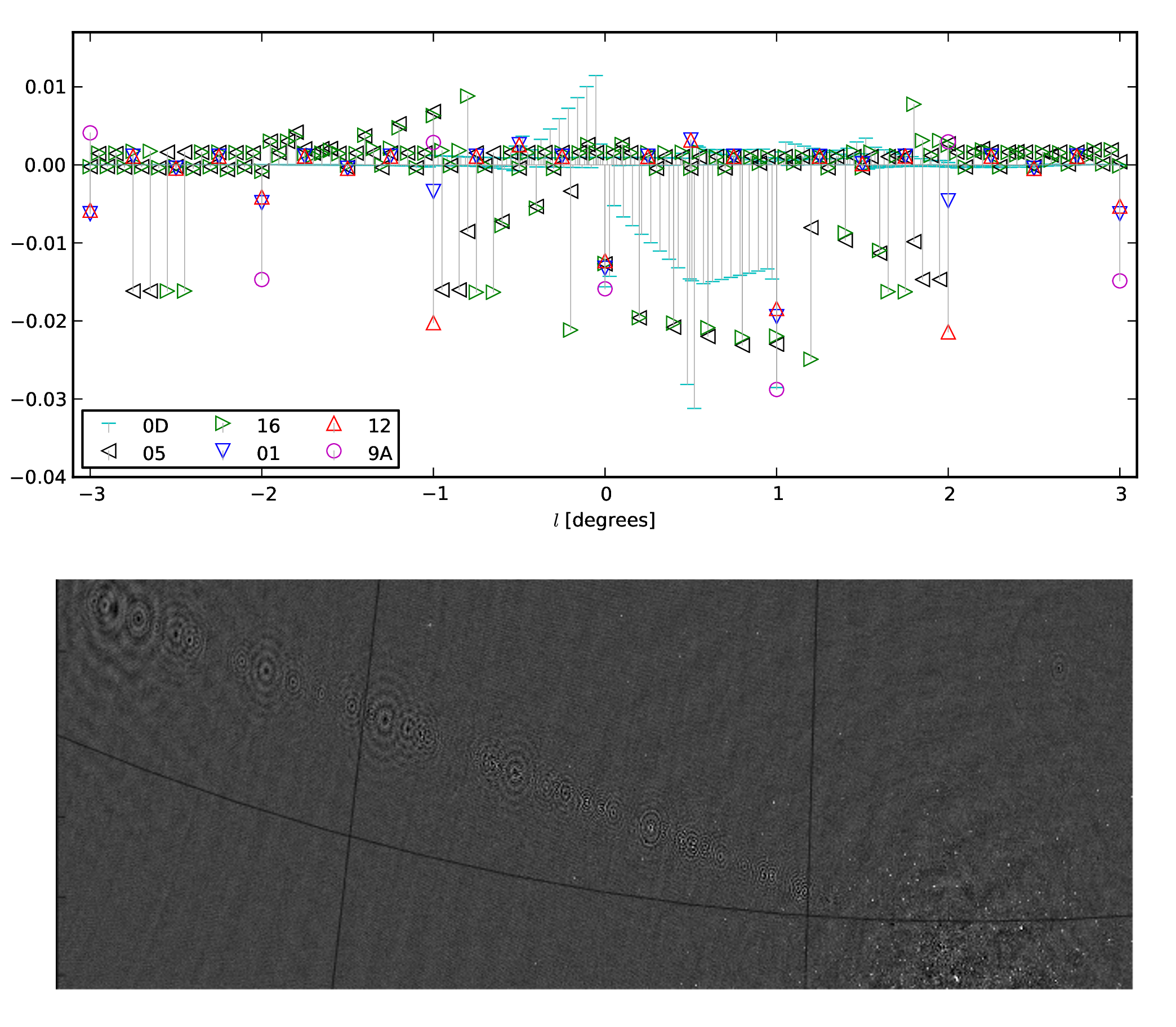Daily Image
28-02-2014Ghostbusted
| Submitter: | Trienko Grobler, Ridhima Nunhokee & Oleg Smirnov |
| Description: | Selfcal "ghosts" are a mystery with a long ASTRON heritage. They were first spotted by Ger de Bruyn in a 2004 WSRT 92cm observation (bottom panel above). The ghosts were a line of source-like and (mostly) negative artefacts, arranged along a line linking the brightest source in the field (bottom right) with Cyg A (top left), which was coming in through a sidelobe about 20 deg away. Some of their more fascinating features -- the regularity of the pattern, the PSF-like sidelobes that were nonetheless substantially different from ghost to ghost, etc. -- caused a lot of discussion at the time. But with no adequate explanation presenting itself, they seemed destined to be forgotten as yet another one-off interferometric artefact, but for Jan Noordam keeping a slowly yellowing printout of the map pinned to his whiteboard for the next six years. (Incidentally, this may also explain the appearance of ghosts at his retirement party: https://picasaweb.google.com/114403768477857029527/JANFEST1562012?authuser=0&authkey=Gv1sRgCOja1o-ymIy6mQE&feat=directlink#5754765617665658754 ) In 2010, during Ger and Oleg Smirnov's Quality Monitoring Committee project, the pattern emerged again. This time, we could empirically reproduce the ghosts using MeqTrees simulations. It quickly became apparent that ghosts were associated with missing sources in the sky model, and that they somehow seemed fundamental to the selfcal process. The exact mechanism, however, remained unclear, and neither could the puzzling features be explained. Thanks to some recent work at Rhodes University and SKA South Africa, the puzzle is now solved, at least for WSRT. Ghosts are indeed due to calibration solutions trying to "compensate" for missing model sources. We now have a theoretical framework for predicting their emergence (to which earlier work by Stefan Wijnholds and Alle-Jan van der Veen contributed some crucial insights). The mathematically-inclined are encouraged to indulge in a recently accepted paper http://arxiv.org/abs/1402.1373). The top panel above summarizes the theoretical predictions in a simple two-source sky, one-source model scenario (where the missing source is at +1 deg). After calibration, each baseline "sees" its own set of ghosts; these are arranged at fixed intervals inversely proportional to baseline length, with varying amplitudes. The plot shows the positions and amplitudes of these ghosts for a selection of baselines. Baseline 0D yields the shortest intervals, while 9A yields the longest. Note that redundant baselines (here, 01 and 12, 05 and 16) produce ghosts at the same positions but with different amplitudes (sometimes even of opposite sign!). Due to WSRT's highly regular configuration, some positions end up hosting ghosts from many baselines, and it is there that we ultimately see the strongest ghosts in the resulting maps. The "ghost spread function" at each position is determined by which baselines actually contribute to it, and therefore varies from ghost to ghost. The negative ghost at 1 deg (sitting on top of the unmodelled source, negative on all baselines and thus producing the strongest overall response) is actually routinely known under the guise of "flux suppression". The remarkable thing about this plot is how a relatively simple mathematical process can yield such a rich variation! It turns out that ghosts have always been with us, quietly sitting under the noise in all observations. This is a worry for future deep surveys and statistical detection techniques, and must be understood further. For 2D arrays, the mechanism becomes more complicated (and the pattern less regular), and we're currently working to explain it. Ger has recently spotted a ghost at the -1 ("anti-source") position in LOFAR observations, and so has the LOFAR Transients KSP. Clearly, Jan needs to keep that old map pinned up for a while yet. |
| Copyright: | Rhodes University, SKA SA & ASTRON |
| Tweet |  |
